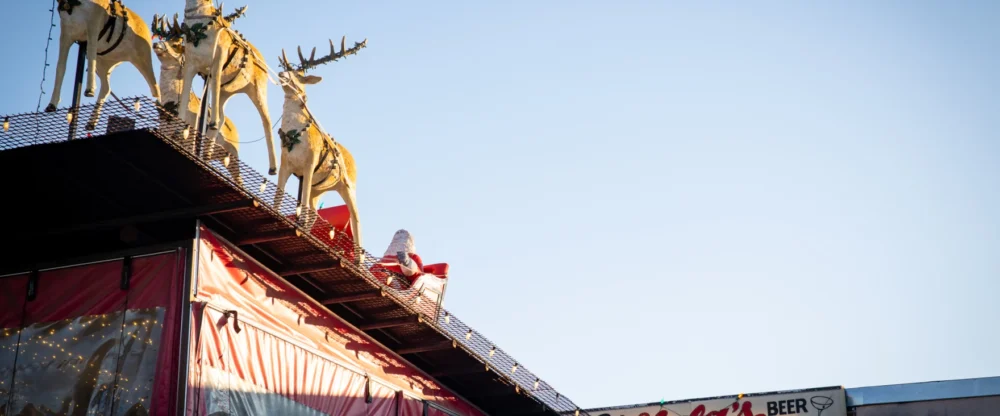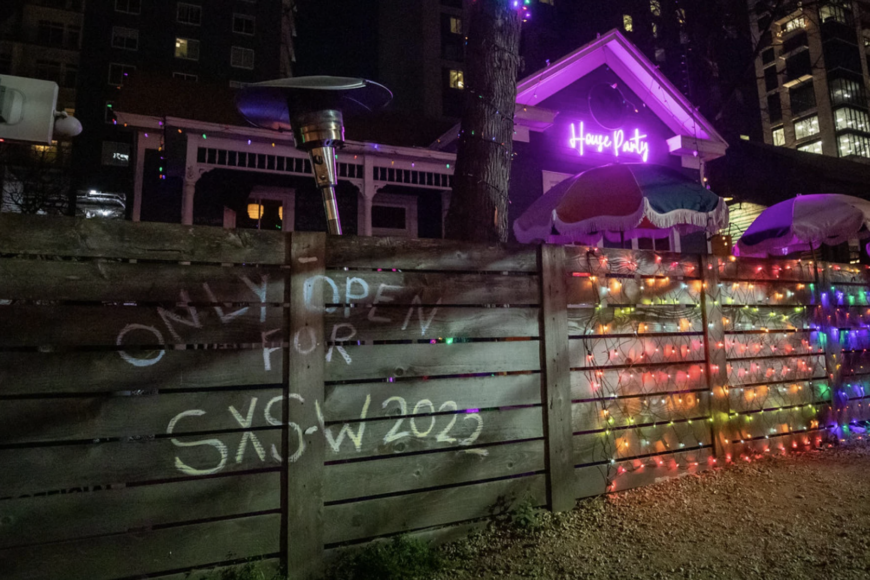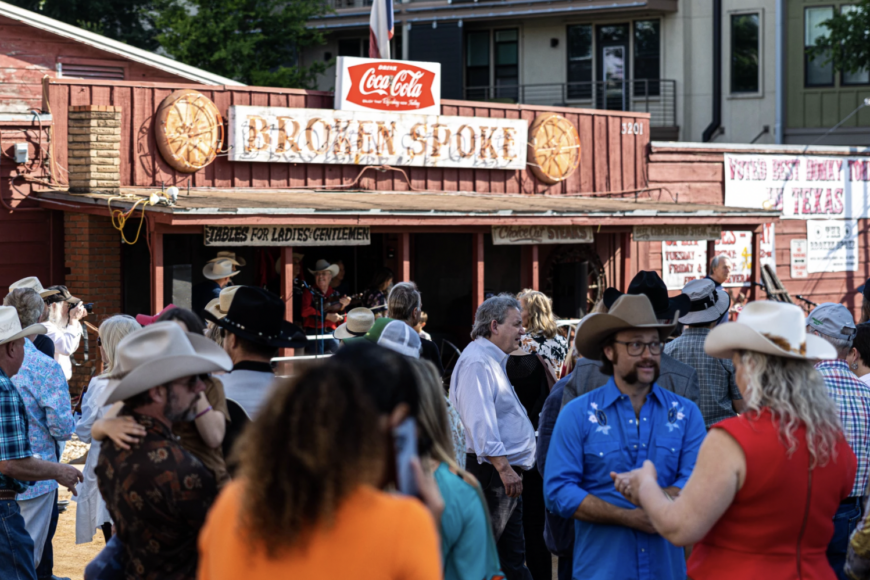KUT 90.5 | By Marisa Charpentier / Published July 20, 2023 at 5:01 AM CDT
There’s a place in Austin where it’s been Christmas every day since 1972.
If you drive around the Crestview area, you can’t miss it: Santa’s sleigh and reindeer perch on the roof of a small dive bar called Lala’s Little Nugget. They’re always there, even in the dead of summer.
Inside, red and green ornaments dangle from the ceiling, Christmas lights line the walls and snow globes and fake evergreens fill every nook. The bar still feels like it’s stuck in the ’70s. A Velvet Elvis painting hangs near the entrance, and in the back, people play pool on an old table or look through songs on a jukebox that hasn’t been updated in decades.
Back in the day, though, the space was truly a hole in the wall, says Angela Reed. She used to go to Lala’s a lot in the ’90s, when she lived in the neighborhood.
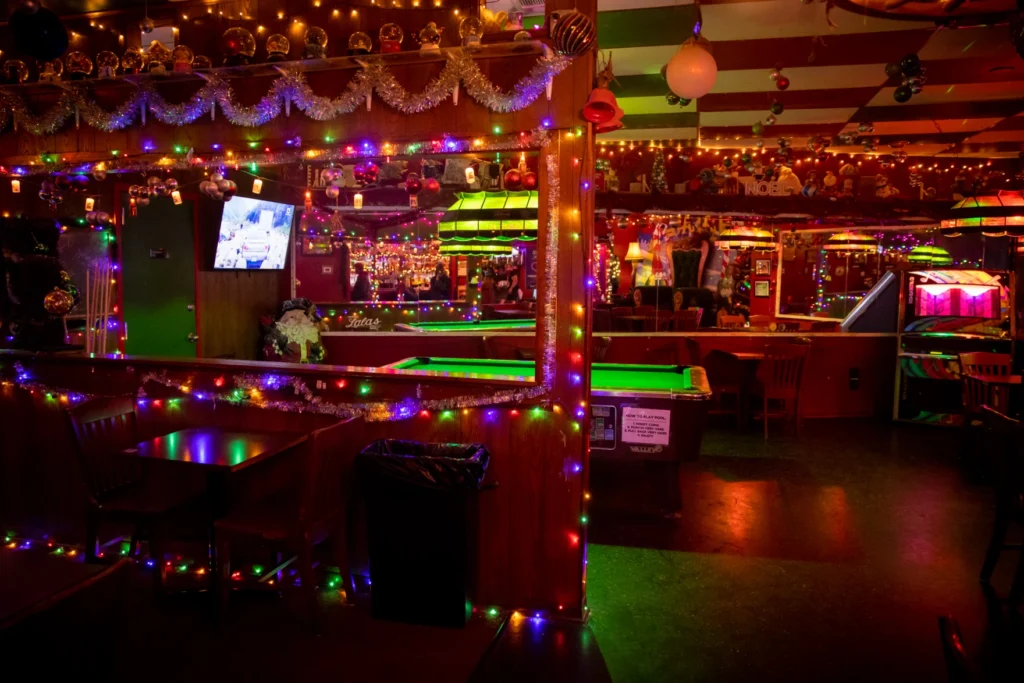
“It was dark, smoky, and just kind of [had] old Christmas ornaments in there,” she said. “Today, it seems like they’ve freshened it up, and it’s almost like they decorated it to be this way. But back then it seemed like, no, they had been there for a long time.”
She remembers there was a story back then about why the decorations were always there.
“The owner owned this bar with her husband, and they had decorated for Christmas,” Reed said. “He left her on Christmas Eve, and so almost as a vengeance, she kept the bar and never changed the decor.”
But Reed wanted to know if the story was true. So, she reached out to KUT’s ATXplained project.
A stroll through Lala’s
To find out, Reed and I took a trip to Lala’s. We figured someone hanging out at the bar would know the answer, so we walked around, asking strangers: Why is it always Christmas at Lala’s?
We first posed the question to an older man and his friends sitting on the patio. They’d been coming to the bar for years but didn’t know the story. Then, a young, sort of hipster guy who was eavesdropping nearby leaned over to us.
“I’ve heard a tragic story about how the owner’s daughter died on Christmas or Christmas Eve,” he said. “He’s dealt with it by making the decor of the bar Christmas all year long.”
OK, intriguing.
Then, we spotted a table of people wearing Lala’s T-shirts. That seemed pretty official, so we went up to them. The group, also regulars, laughed at the question and shared a less interesting tale: The original bar owner was a woman who loved Christmas. She put the decorations up and just never took them down.
But one of the people at the table told us to look up a Kenny Chesney song called “Jesus and Elvis.” The lyrics to it were supposedly inspired by Lala’s. So, I started researching.
It turns out the song was originally written by Texas musician Hayes Carll, who used to spend a lot of time at Lala’s. In a video, he says he was curious about the story behind the Christmas decor so he started asking around.
“What I heard was a tragic one,” Carll said. “It was that Lala had a son who had gone off to fight in Vietnam at Christmas time, and she promised she wouldn’t take the lights down until he made it back home. All these years later those lights are still hanging up there.”
So, let’s review: An ex-lover. A tragic death. Just a general love of Christmas. A son killed at war.
This can’t all explain why Lala’s is always decorated for Christmas, right? To get the real story, I’d need to get someone official on the record.
Lala’s little legends
These days, Lala’s is owned by a company called FBR Management, which runs about a dozen bars in Austin. It took over Lala’s when the original owner retired about eight years ago. I met up with Max Moreland, the company’s chief operations officer, and asked him why Lala’s is always decorated for Christmas.
He told me there are three main rumors:
- The owner’s husband left her on Christmas. She fell into a depression and just never took the decorations down.
- The owner decorated the bar for Christmas one year, and when the holidays were over, she took them down. But the bar felt too naked, so she put them all up again.
- The owner’s son went off to war in Vietnam. She swore the decorations would stay up until her son came home. He never did.
One of the rumors is true, Moreland said, but he refused to say which one.
“It’s … whatever you want to believe in,” he said. “It’s like Santa, you know, it’s up to you. It’s open for interpretation.”
To learn the real story, I’d need to learn more about the woman behind the bar.
A woman named Frances
On the wall across from the bar, there’s a framed black and white photo of a woman with short, dark hair. Her eyes squint behind a pair of cat-eyed glasses as she smiles in front of a window painted with the words “Lala’s Little Nugget.” Her name was Frances, and she started Lala’s back in the 1970s.
“She was tough. She was hard to impress,” said Mike Lavigne, a Lala’s regular and friend of Frances’. “I mean, we didn’t hang out socially outside the bar, but I don’t know that she was ever outside that bar. I’m fairly certain that if the bar was open, she was there.”
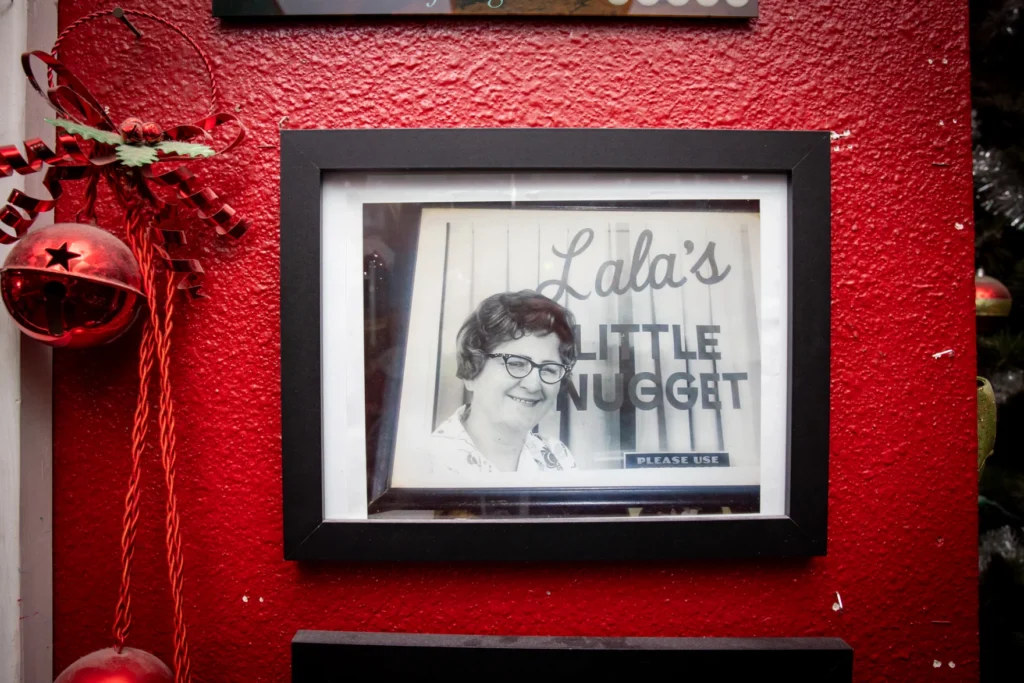
Frances ran Lala’s for some 40 years, until she retired in 2015. She died two years later.
“One of the reasons that she created Lala’s … was because she wanted a place where women could feel safe to drink alone,” Lavigne said. “She created a, you know, in modern parlance, a safe space to do that.”
Typically, it was just Frances and her business partner, Sara Santos, behind the bar making drinks.
“Frances would never overpour your drink,” Lavigne said. “So, if you ordered a Jameson on the rocks, it was going to be two fingers of Jameson, and that is it. No more, no less. And she had little fingers.”
Frances was also a private person. She didn’t share a lot about her family or her background.
“There she was behind that bar for 35-whatever years, and nobody knew anything about her,” Lavigne said.
For example, it wasn’t until Frances died that Lavigne learned her full name. He’d always thought the name Lala’s was Christmas-y, but at her funeral Lavigne — one of the pallbearers — looked down at the program and saw her last name was Lala.
“It was her last name all along,” he said. “And it sounds silly, but, like, that would have jibed with her sense of humor.”
Frances was the kind of person who’d keep Christmas lights up well past the month of December, and then, when Halloween would come around, she’d think it was funny to just put Halloween decorations over the Christmas ones. She was the kind of person, Lavigne said, to embellish the truth just to mess with people.
So, I asked him about the rumors behind Lala’s Christmas decorations — the husband who left on Christmas, the son sent off to war.
“She would have absolutely exaggerated on the story to mess with the college kids in the ’80s,” he said. “No doubt in my mind, like, that’s her M.O. all the way. She liked to mess with folks. But that doesn’t mean that none of it’s true.”
Lavigne wouldn’t say which story was true either. He didn’t want to set the record straight. He brought up an old phrase I’d heard before: “Print the legend. Don’t worry about the truth.” The idea that sometimes in life the stories we tell ourselves become bigger than the truth.
“I mean, look … people don’t remember her as maybe the most warm human being that ever walked the earth,” Lavigne said. “But the fact is that she created this place that has a sense of humor about it and is a safe place for people to come and hang out. And so clearly, she was a warm person and clearly she was somebody who cared about her fellow human. And I think that is the legacy of the bar. And the story’s fun or sad or interesting, or whatever you need it to be.”
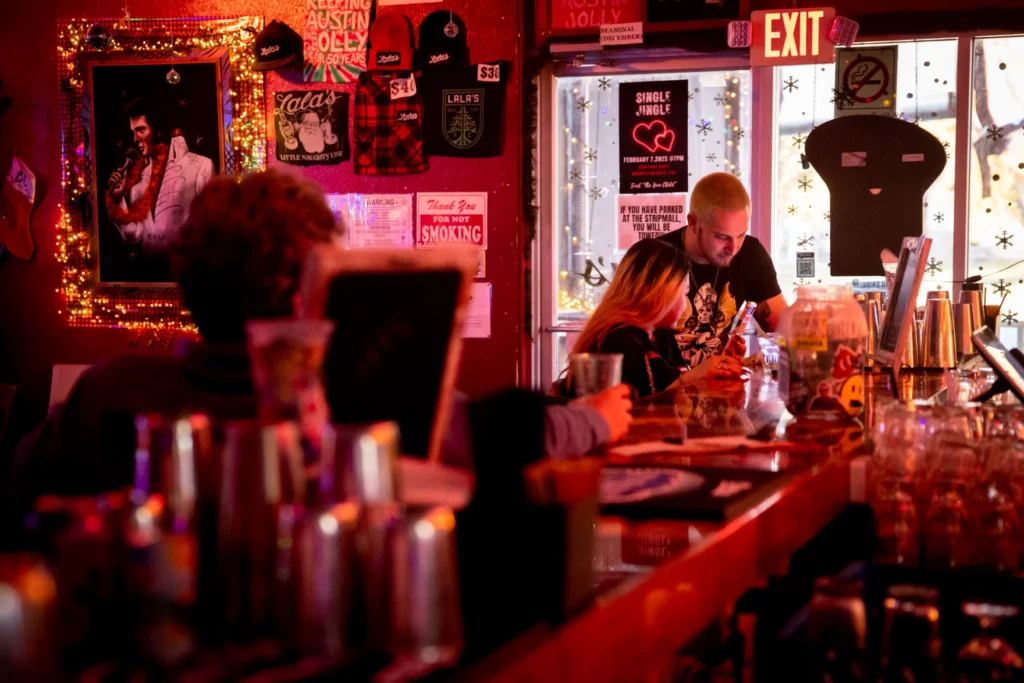
Now, for the sake of honesty, I will say someone did tell me which story is the true story. But in writing this, I kept thinking back to that phrase “print the legend.” It’s actually part of a longer quote from an old Western called The Man Who Shot Liberty Valance. In the movie, a newspaper editor gets a scoop. He learns the story that’s long been told about the person who killed the local outlaw is actually a myth. But the editor decides not to reveal the truth. Instead, he crumples up the story and tosses it in the furnace.
“This is the West,” he says. “When the legend becomes fact, print the legend.”
Sometimes the lore of an event or a place is more interesting than what really happened. And in the case of Lala’s, these stories are a way of keeping the memory of Frances alive. They’re the type of gossip or inside joke that brings people together. Like Lavigne said, the story behind Lala’s Christmas decor is whatever you need it to be.
And isn’t that kind of the definition of a good dive bar?
